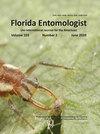受牧场管理影响的红色进口火蚁、无翅Solenopsis invicta(负担)(膜翅目:蚁科)、数量和节肢动物群落多样性
IF 1.2
4区 农林科学
Q3 ENTOMOLOGY
引用次数: 1
摘要
红火蚁(Solenopsis invicta, Buren)(膜翅目:蚁科)是美国东南部最多产的入侵物种之一。这些入侵者优先在高度受干扰的土地和草地栖息地定居。放牧系统中牲畜的管理会对草地生境的干扰程度产生深远的影响,我们假设适应性多围场牧场管理会显著增加美国东南部牧场的invicta丰度,在那里节肢动物多样性会随着invicta丰度的增加而减少。研究了基于放养密度、轮作频率和杀虫剂/驱虫剂施用量的适应性多围场牧场管理制度对土壤、叶面和粪便群落中火蚁丘丰度和节肢动物多样性的影响。沿样线记录了6个牧场的无尾索兰丘和丘区。沿同一样线采集土壤和叶面节肢动物群落,并在放牧系统内取样粪便群落。与传统放牧方式相比,多围场适应性放牧方式下的不可胜草丘增加了3.4倍,丘面积增加了4.6倍。然而,在3个节肢动物群落中,节肢动物多样性与invicta丰度均不相关。本研究表明,适应性多围场牧场管理可以增加invicta群落的丰度,但适应性多围场牧场节肢动物群落的多样性不会因invicta丰度的增加而减少。本文章由计算机程序翻译,如有差异,请以英文原文为准。
Red Imported Fire Ant, Solenopsis invicta (Burden) (Hymenoptera: Formicidae), Abundance and Arthropod Community Diversity Affected by Pasture Management
Abstract The red imported fire ant, Solenopsis invicta (Buren) (Hymenoptera: Formicidae), is one of the most prolific invasive species in the southeastern US. These invaders preferentially colonize highly disturbed land and grassland habitat. Management of livestock in pasture systems can have a profound impact on the level of disturbance in grassland habitats, and we hypothesized that adaptive multi-paddock pasture management would significantly increase S. invicta abundance in southeastern US pastures where arthropod diversity would decrease as S. invicta abundance increases. We studied the effects that adaptive multi-paddock pasture management systems (based on stocking density, rotation frequency, and insecticide/anthelmintic [wormer] application rates) have on fire ant mound abundance and arthropod diversity for the soil, foliar, and dung communities. Solenopsis invicta mounds and mound areas were documented along transect lines in 6 pastures. Soil and foliar arthropod communities were collected along the same transect lines, and dung communities were sampled from pats within the pasture system. Pastures managed under adaptive multi-paddock practices had 3.4× more S. invicta mounds and 4.6× more mound area than their conventionally managed counterparts. However, arthropod diversity did not correlate with S. invicta abundance in any of the 3 arthropod communities sampled. This study shows adaptive multi-paddock pasture management can increase S. invicta mound abundance, but arthropod communities in adaptive multi-paddock pastures do not suffer decreased diversity from increased abundance of S. invicta.
求助全文
通过发布文献求助,成功后即可免费获取论文全文。
去求助
来源期刊

Florida Entomologist
生物-昆虫学
CiteScore
2.10
自引率
7.10%
发文量
44
审稿时长
3 months
期刊介绍:
Florida Entomologist is the official journal of the Florida Entomological Society. Volumes 1-3 were published under the name The Florida Buggist. The Florida Entomological Society still produces the traditionally printed version of Florida Entomologist, but you can also view, search, or print any article published since June 1917 by accessing online files. Web access is made possible by the Society’s electronic publication project begun in 1993
 求助内容:
求助内容: 应助结果提醒方式:
应助结果提醒方式:


